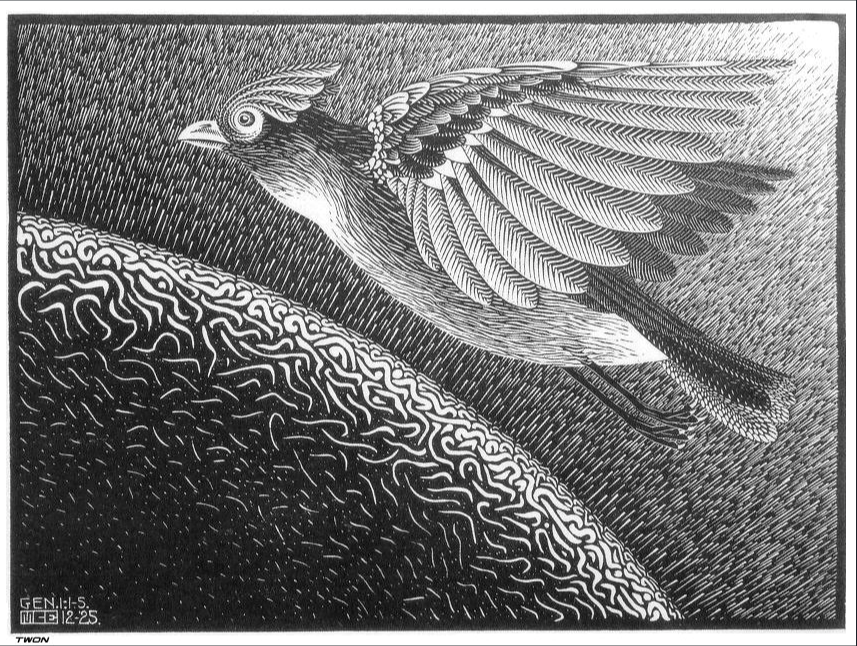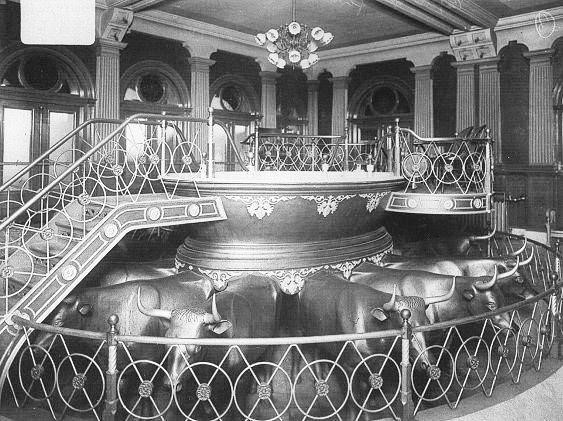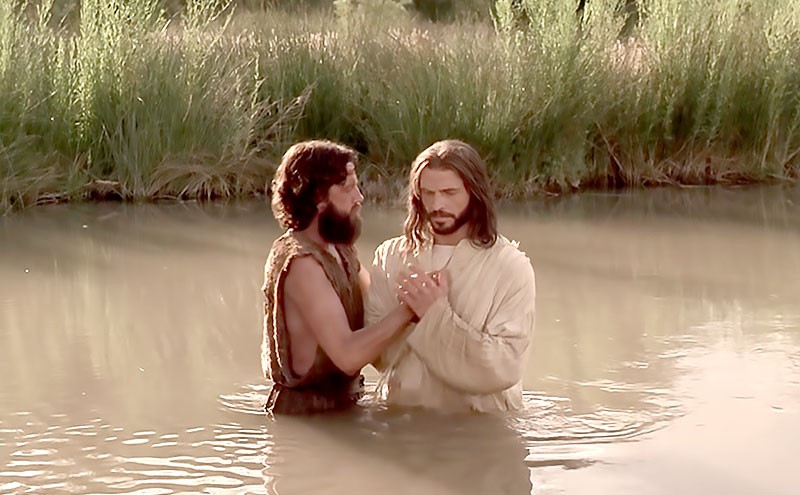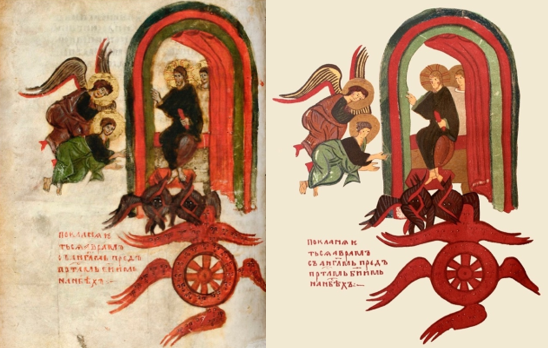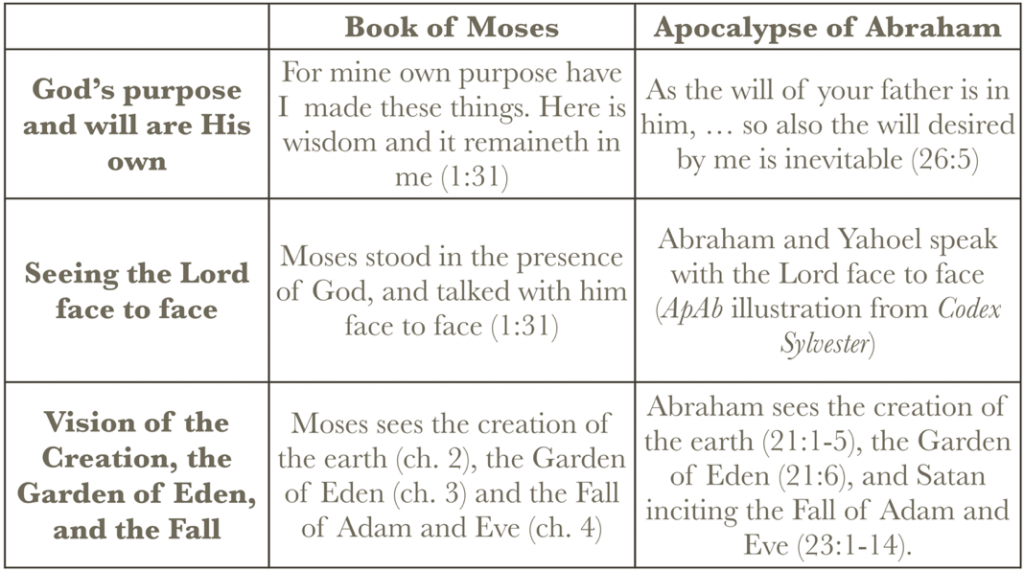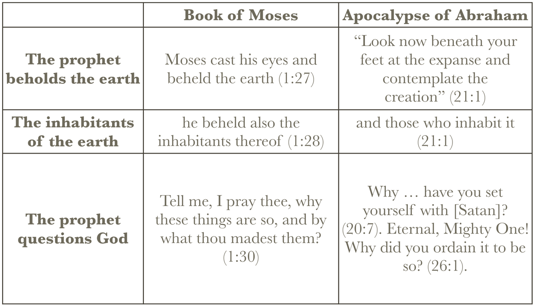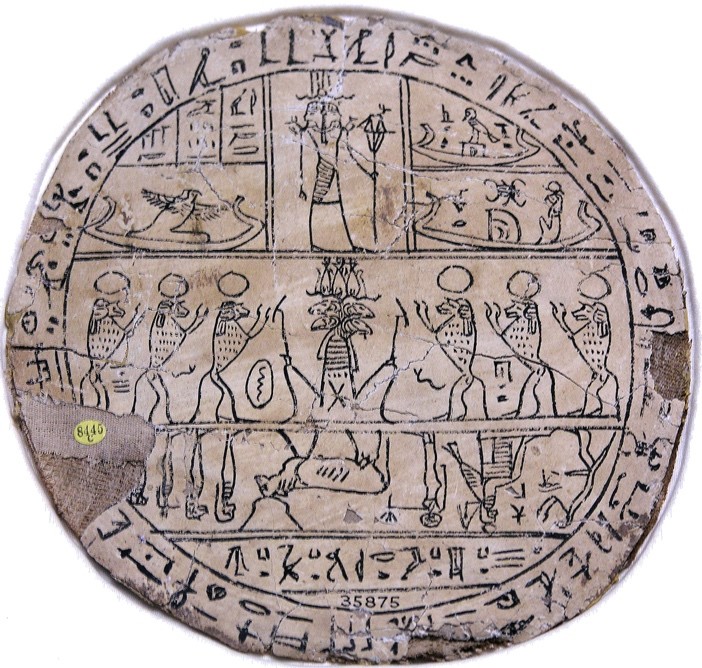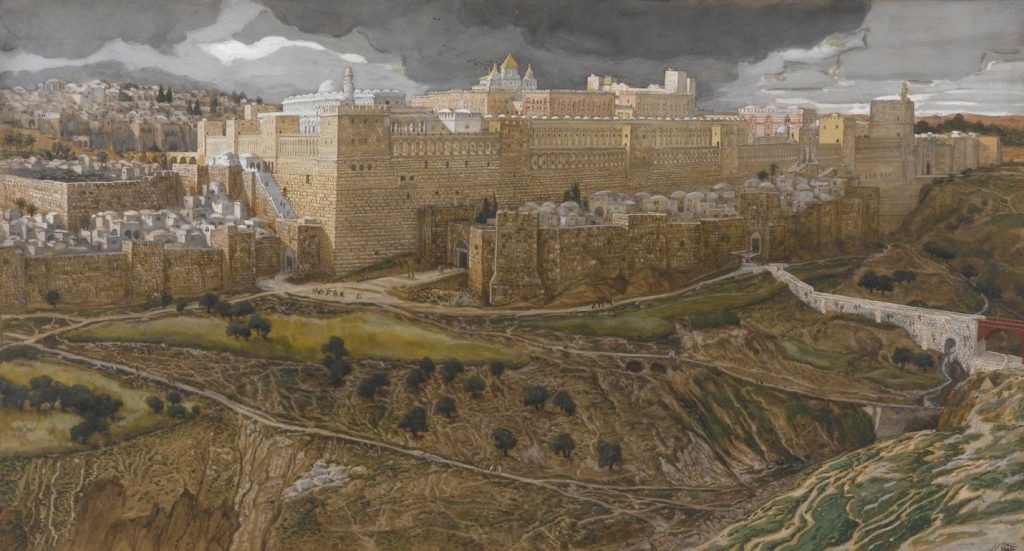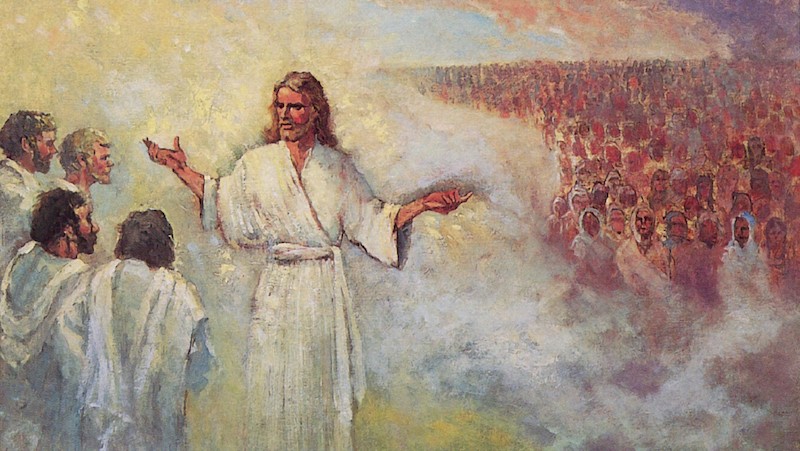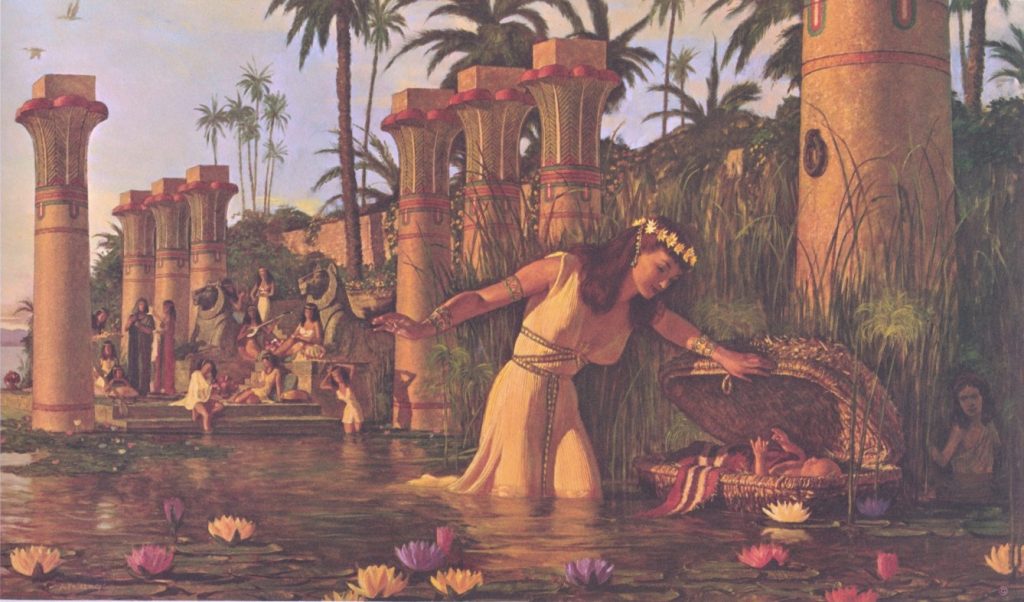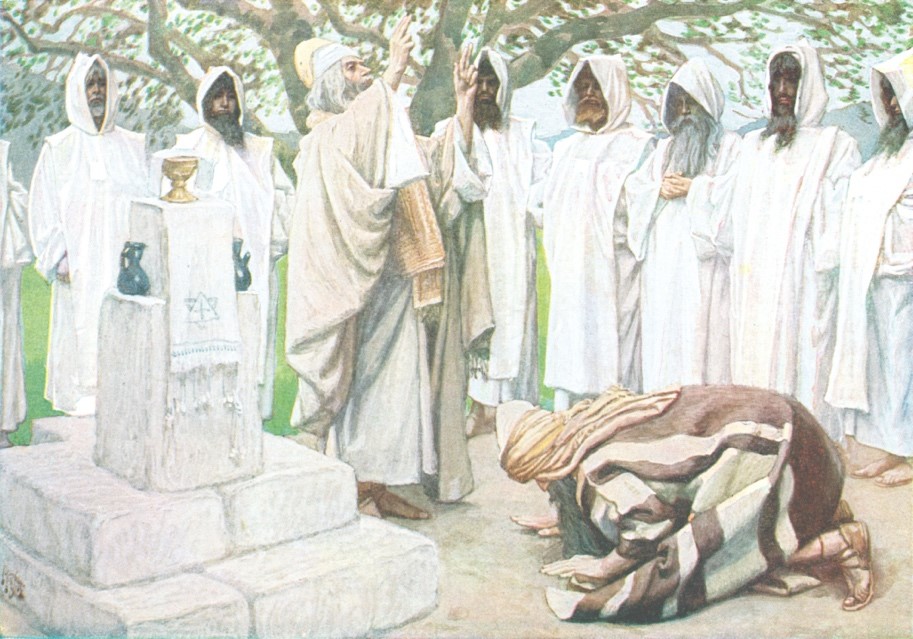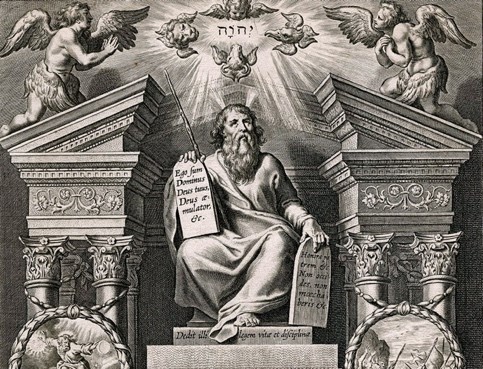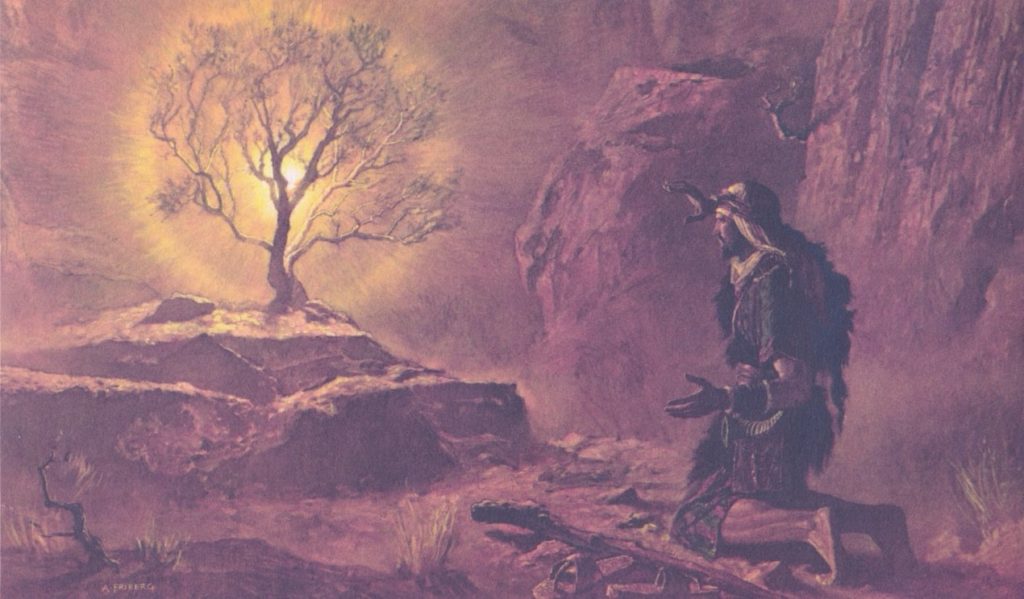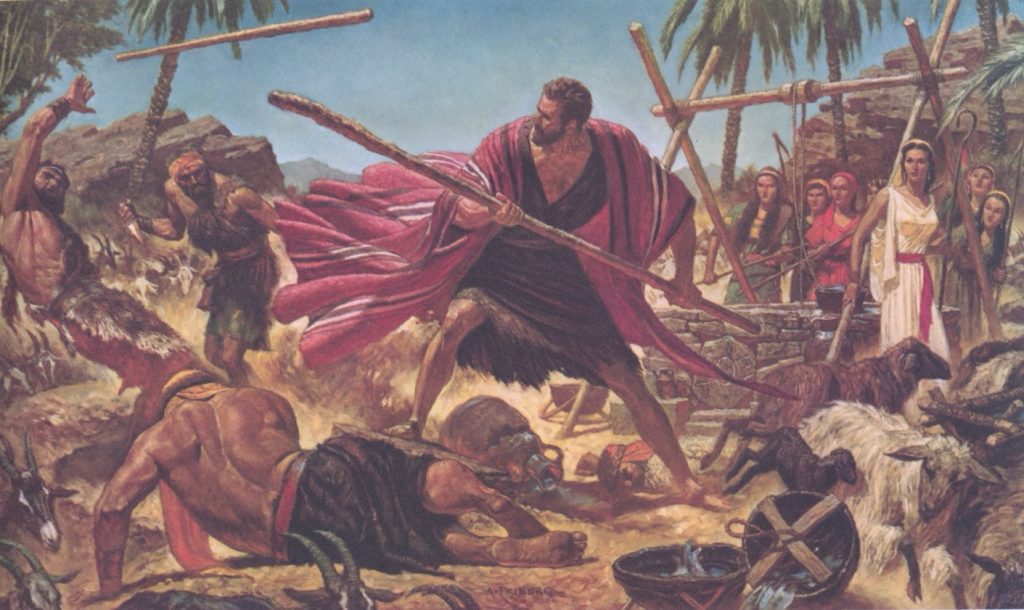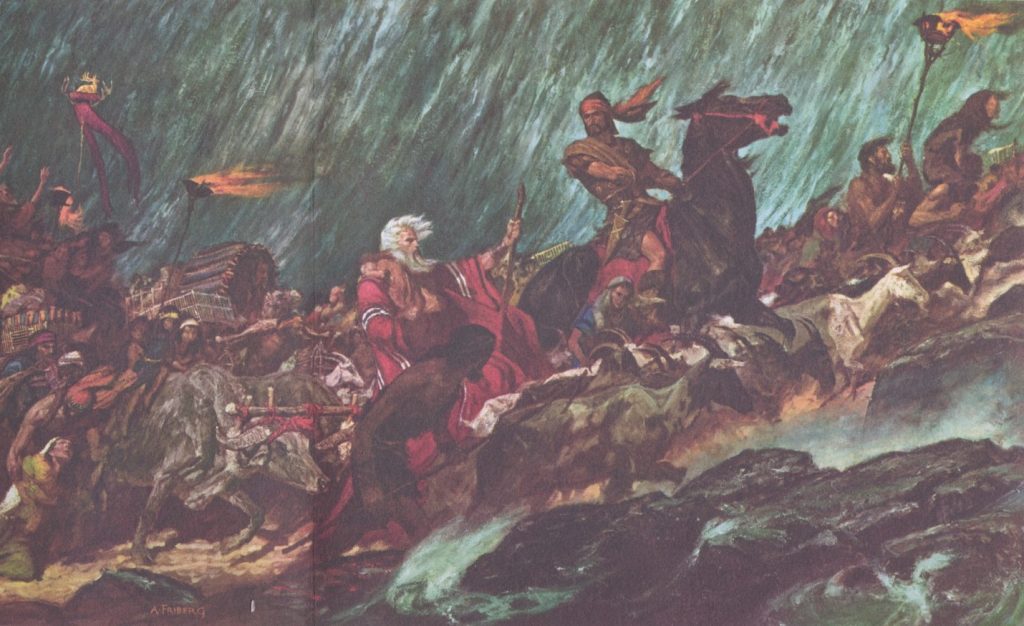Book of Moses Essay #46
Moses 2:1-27
With contribution by Jeffrey M Bradshaw
The illustration above from M. C. Escher depicts the first day of Creation, when “the earth was without form and void; and I caused darkness to come up upon the face of the deep; and my Spirit moved upon the face of the water; for I am God.”1 The Hebrew term here translated “moved” is used in Deuteronomy 32:11 to describe an eagle hovering attentively over its young.2 In addition, one cannot help but recall the imagery of Jesus’ mourning for Jerusalem: “O Jerusalem, Jerusalem, … how often would I have gathered thy children together, even as a hen gathereth her chickens under her wings, and ye would not!”3
Consistent with such a picture, the Book of Abraham employs the term “brooding,”4 the patient action of a mother bird by which eggs are incubated before they hatch. The imagery of “brooding” highlights not only the loving care of the Creator for His Creation, but may also allude to atonement symbolism. For example, Margaret Barker admits the possibility of a subtle wordplay in examining the reversal of consonantal sounds between “brood/hover” and “atone.”5 Atonement is arguably the central symbolism of Israelite temples, and may be reflected not only in the symbolism of Day One of Creation but also in the overall schema for the unfolding of the universe, as we outline in more detail below.
While it is true that some significant details were added to Genesis in the translation of Moses 2, it is perhaps more noteworthy that the effort resulted in no major reshaping of the creation story itself.6 As to the significant details, a brief prologue affirming that the account derives from the words of the Lord directly to Moses is added in verse 1. The repetition of the phrase “I, God” throughout the chapter also emphasizes its firsthand nature. Importantly, the fact that all things were created “by mine Only Begotten”7 is made clear, as is the Son’s identity as the co-creator at the time when God said “Let us make man.”8 Consistent with the words of Christ to the Brother of Jared,9 we learn that man was created in the image of the Only Begotten, which is equated to being created in God’s own image.10 Apart from these important points, the structure and basic premises of the Genesis account of the Creation were left intact.
That said, in reading the description of the seven days of Creation and the layout of the Garden of Eden, there seems to be more than meets the eye—including hints of temple themes. Can some of the enigmas of the Creation accounts be resolved through an understanding of the architecture of the Israelite temples? I believe so.
Differences Among the Four Basic Creation Stories
The Latter-day Saints have four basic Creation stories — found in Genesis, the Book of Moses, the Book of Abraham, and the temple. In contrast to latter two accounts that emphasize the planning of the heavenly council and the work involved in setting the cosmological, geological, and biological processes in motion, the companion accounts of Genesis and the Book of Moses seem deliberately designed to relate the heavenly creation of the universe to the layout of the physical temple on earth. In addition, as we will see in a later essay,11 careful study of the first chapters of Genesis and the Book of Moses also reveals that not only the Creation, but also the Garden of Eden provided a model for the architecture of the temple.
The day-by-day description found in Genesis and the Book of Moses seem to have been deliberately shaped to highlight a step-by-step correspondence between the creation of each element of the universe and the architecture and furnishings of the Tabernacle and later Israelite temples. Understanding these parallels helps explain why, for example, in seeming contradiction to scientific understanding,12 the description of the creation of the sun and moon appears after, rather than before, the creation of light and of the earth. In Genesis and the Book of Moses, conveying the spiritual truths of how heavenly realities are symbolically reflected in earthly temples takes precedence over the scientific truths of how the Creation unfolded in physical processes over long time periods.
With this in mind, it becomes clear that the Genesis and Book of Moses creation accounts should not be quickly dismissed as naïve and outdated pre-scientific cosmology. Rather, they should be read as sophisticated reflections of temple theology. While relevant to ancient Israelite tradition, they are also of special interest to Latter-day Saint temple goers.
The Days of Creation and Temple Architecture
Building on threads in Jewish tradition, Old Testament scholar Margaret Barker suggests that the architecture of the tabernacle and ancient Israelite temples is modeled on Moses’ vision of the creation.13 In this view, the results of each day of Creation are symbolically reflected in temple furnishings. For example, the light of day one of Creation might be understood as the glory of God and those who dwelled with Him in the celestial world prior to their mortal birth. According to this logic, the temple veil that divided the temple Holy of Holies from the Holy Place would symbolize the “firmament” that was created to separate the heavens from the earth in its original, terrestrial state.14
A closer look at the word “firmament” in Hebrew confirms this interpretation as plausible. Joseph Smith translated Abraham 4:6 as “expanse” instead of “firmament.” The Prophet’s choice of the word “expanse” seems to have been based on the Hebrew grammar book that he used during his study of Hebrew in Kirtland.15 According to biblical scholar Nahum Sarna: “The verbal form [of the Hebrew term] is often used for hammering out metal or flattening out earth, which suggests a basic meaning of ‘extending.’”16 This could well apply to the idea of the spreading out of a curtain or veil. In light of correspondences between the story of Creation in Genesis and the making of the Tabernacle in Exodus, the concept of the firmament as a veil merits further study as a contrasting alternative to other biblical descriptions where it is clearly understood (misunderstood?) as a solid dome.17
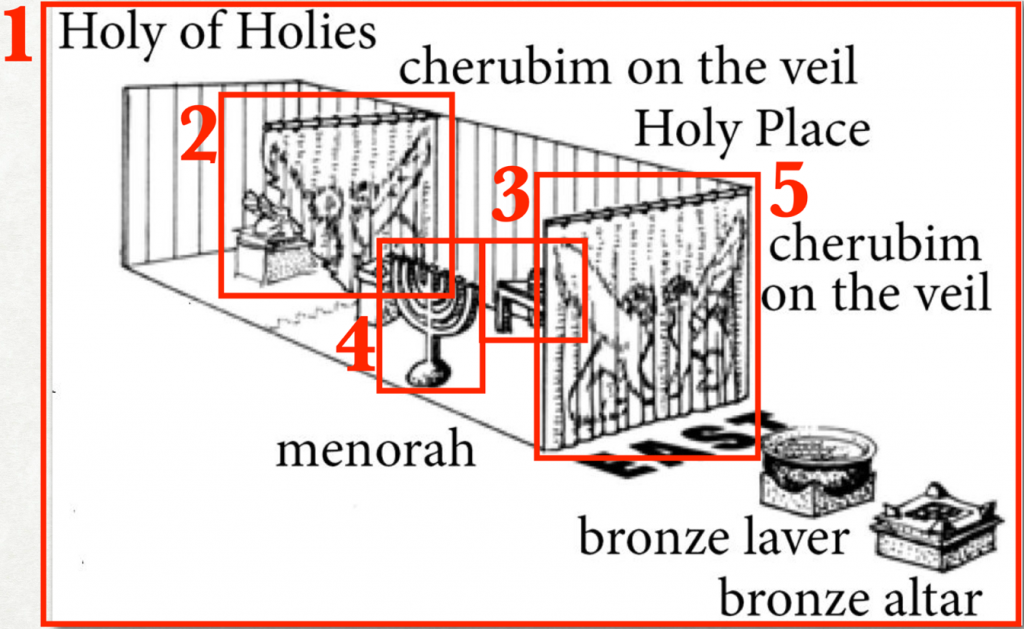
Louis Ginzberg’s reconstruction of ancient Jewish sources is consistent with this overall idea,18 as well as with the suggestion of several scholars that a narrative of the Creation story something like Genesis 1 may have been used within temple ceremonies in ancient Israel:19
[1] God told the angels: On the first day of creation, I shall make the heavens and stretch them out; so will Israel raise up the tabernacle as the dwelling place of my Glory.20
[2] On the second day I shall put a division between the terrestrial waters21 and the heavenly waters, so will [my servant Moses] hang up a veil in the tabernacle to divide the Holy Place and the Most Holy.22
[3] On the third day I shall make the earth to put forth grass and herbs; so will he, in obedience to my commands, … prepare shewbread before me.23
[4] On the fourth day I shall make the luminaries;24 so he will stretch out a golden candlestick [menorah] before me.25
[5] On the fifth day I shall create the birds; so he will fashion the cherubim with outstretched wings.26
[6] On the sixth day I shall create man; so will Israel set aside a man from the sons of Aaron as high priest for my service.27
Carrying this idea forward to a later time, Exodus 40:33 describes how Moses completed the Tabernacle. The Hebrew text exactly parallels the account of how God finished creation.28 Genesis Rabbah comments on the significance of this parallel: “It is as if, on that day [i.e., the day the Tabernacle was raised in the wilderness], I actually created the world.” 29 With this idea in mind, Hugh Nibley famously called the temple “a scale-model of the universe.”30
The idea that the process of creation provides a model for subsequent temple building and ritual31 is found elsewhere in the ancient Near East. For example, this is made explicit in Hugh Nibley’s reading of the first, second, and sixth lines of the Babylonian creation story, Enuma Elish: “At once above when the heavens had not yet received their name and the earth below was not yet named … the most inner sanctuary of the temple … had not yet been built.”32 Consistent with this reading, the account goes on to tell how the god Ea founded his sanctuary (1:77),33 after having “established his dwelling” (1:71), “vanquished and trodden down his foes” (1:73), and “rested” in his “sacred chamber” (1:75).
Conclusion
Understanding the similitude that the account of Moses makes between the days of Creation and the temple explains its divergences from strictly scientific accounts. This temple symbolism in Creation will also be essential in understanding the layout of the Garden of Eden and the events of the Fall. Temple-going Latter-day Saints are in the best position of any living group to interpret these stories in their original context.
This article is adapted and updated from Bradshaw, Jeffrey M. “The LDS book of Enoch as the culminating story of a temple text.” BYU Studies 53, no. 1 (2014): 39–73. http://www.templethemes.net/publications/140224-a-Bradshaw.pdf, pp. 47-50. (accessed September 19, 2017).
Further Reading
Bailey, David H., Jeffrey M. Bradshaw, John H. Lewis, Gregory L. Smith, and Michael L. Stark, eds. Science and Mormonism: Cosmos, Earth, and Man. Interpreter Science and Mormonism Symposia 1. Orem and Salt Lake City, UT: The Interpreter Foundation and Eborn Books, 2016. www.templethemes.net.
Bradshaw, Jeffrey M. Creation, Fall, and the Story of Adam and Eve. 2014 Updated ed. In God’s Image and Likeness 1. Salt Lake City, UT: Eborn Books, 2014. www.templethemes.net, pp. 83-84, 97-98, 104.
Bradshaw, Jeffrey M. Temple Themes in the Book of Moses. 2014 update ed. Salt Lake City, UT: Eborn Publishing, 2014. www.tempelethemes.net, pp. 54-55.
Bradshaw, Jeffrey M. “The LDS book of Enoch as the culminating story of a temple text.” BYU Studies 53, no. 1 (2014): 39–73. http://www.templethemes.net/publications/140224-a-Bradshaw.pdf, pp. 47-50. (accessed September 19, 2017).
Draper, Richard D., S. Kent Brown, and Michael D. Rhodes. The Pearl of Great Price: A Verse-by-Verse Commentary. Salt Lake City, UT: Deseret Book, 2005, pp. 177-236.
References
Alexander, T. Desmond. From Eden to the New Jerusalem: An Introduction to Biblical Theology. Grand Rapids, MI: Kregel, 2008.
Augustine. d. 430. St. Augustine: The Literal Meaning of Genesis. New ed. Ancient Christian Writers 41 and 42. Mahwah, NJ: Paulist Press, 1982.
Bailey, David H., Jeffrey M. Bradshaw, John H. Lewis, Gregory L. Smith, and Michael L. Stark, eds. Science and Mormonism: Cosmos, Earth, and Man. Interpreter Science and Mormonism Symposia 1. Orem and Salt Lake City, UT: The Interpreter Foundation and Eborn Books, 2016.
Barker, Margaret. “Atonement: The rite of healing.” Scottish Journal of Theology 49, no. 1 (1996): 1-20. http://www.abdn.ac.uk/~div054/sjt. (accessed August 3).
———. The Revelation of Jesus Christ: Which God Gave to Him to Show to His Servants What Must Soon Take Place (Revelation 1.1). Edinburgh, Scotland: T&T Clark, 2000.
———. “The veil as the boundary.” In The Great High Priest: The Temple Roots of Christian Liturgy, edited by Margaret Barker, 202-28. London, England: T & T Clark, 2003.
———. E-mail message to Jeffrey M. Bradshaw, June 11, 2007.
———. The Hidden Tradition of the Kingdom of God. London, England: Society for Promoting Christian Knowledge (SPCK), 2007.
Bradshaw, Jeffrey M. Creation, Fall, and the Story of Adam and Eve. 2014 Updated ed. In God’s Image and Likeness 1. Salt Lake City, UT: Eborn Books, 2014. https://archive.org/download/140123IGIL12014ReadingS.
Bradshaw, Jeffrey M., and David J. Larsen. Enoch, Noah, and the Tower of Babel. In God’s Image and Likeness 2. Salt Lake City, UT: The Interpreter Foundation and Eborn Books, 2014. hhttps://archive.org/download/131203ImageAndLikeness2ReadingS.
Brown, Francis, S. R. Driver, and Charles A. Briggs. 1906. The Brown-Driver-Briggs Hebrew and English Lexicon. Peabody, MA: Hendrickson Publishers, 2005.
Brown, William P. The Seven Pillars of Creation: The Bible, Science, and the Ecology of Wonder. Oxford, England: Oxford University Press, 2010.
Cassuto, Umberto. 1944. A Commentary on the Book of Genesis. Vol. 1: From Adam to Noah. Translated by Israel Abrahams. 1st English ed. Jerusalem: The Magnes Press, The Hebrew University, 1998.
Driver, Samuel Rolles. The Book of Exodus. The Cambridge Bible for Schools and Colleges, ed. A. F. Kirkpatrick. Cambridge, England: Cambridge University Press, 1911. https://archive.org/details/bookofexodusinre00driv/. (accessed August 31, 2020).
Flake, Kathleen. “Translating time: The nature and function of Joseph Smith’s narrative canon.” Journal of Religion 87, no. 4 (October 2007): 497-527. http://www.vanderbilt.edu/divinity/facultynews/Flake%20Translating%20Time.pdf. (accessed February 22, 2009).
Fletcher-Louis, Crispin H. T. All the Glory of Adam: Liturgical Anthropology in the Dead Sea Scrolls. Leiden, The Netherlands: Brill, 2002.
———. 2002. The Cosmology of P and Theological Anthropology in the Wisdom of Jesus ben Sira. In Jewish Roots of Eastern Christian Mysticism, eds. Alexander Golitzin and Andrei A. Orlov. http://www.marquette.edu/maqom/Sirach1.pdf , http://www.marquette.edu/maqom/Sirach2.pdf. (accessed July 2, 2010).
Ginzberg, Louis, ed. The Legends of the Jews. 7 vols. Translated by Henrietta Szold and Paul Radin. Philadelphia, PA: The Jewish Publication Society of America, 1909-1938. Reprint, Baltimore, MD: Johns Hopkins University Press, 1998.
Grey, Matthew J. “Approaching Egyptian papyri through biblical language.” In Producing Ancient Scripture: Joseph Smith’s Translation Projects in the Development of Mormon Christianity, edited by Mark Ashurst-McGee, Michael Hubbard MacKay and Brian M. Hauglid, 390-451. Salt Lake City, UT: University of Utah Press, 2020.
Hahn, Scott W. “Christ, Kingdom, and Creation: Davidic Christology and Ecclesiology in Luke-Acts.” Letter and Spirit 3 (2007): 167-90. http://www.scotthahn.com/download/attachment/1931. (accessed July 2).
Hodges, Horace Jeffery. “Milton’s muse as brooding dove: Unstable image on a chaos of sources.” Milton Studies of Korea 12, no. 2 (2002): 365-92. http://memes.or.kr/sources/%C7%D0%C8%B8%C1%F6/%B9%D0%C5%CF%BF%AC%B1%B8/12-2/11.Hodges.pdf. (accessed August 25, 2007).
Josephus, Flavius. 37-ca. 97. “The Antiquities of the Jews.” In The Genuine Works of Flavius Josephus, the Jewish Historian. Translated from the Original Greek, according to Havercamp’s Accurate Edition. Translated by William Whiston, 23-426. London, England: W. Bowyer, 1737. Reprint, Grand Rapids, MI: Kregel Publications, 1980.
Kearney, Peter J. “Creation and liturgy: The P redaction of Exodus 25-40.” Zeitschrift für die alttestamentliche Wissenschaft 89, no. 3 (1977): 375-87.
Leder, Arie C. “The coherenece of Exodus: Narrative unity and meaning.” Calvin Theologcal Journal 36 (2001): 251-69. http://faculty.gordon.edu/hu/bi/ted_hildebrandt/otesources/02-exodus/Text/Articles/Leder-ExodusCoherence-CTJ.pdf. (accessed July 2).
Levenson, Jon D. “The temple and the world.” The Journal of Religion 64, no. 3 (1984): 275-98. http://www.jstor.org/stable/1202664. (accessed July 2).
McConkie, Bruce R. “Christ and the creation.” Ensign 12, June 1982, 8-15.
Milton, John. 1667. “Paradise Lost.” In Paradise Lost, Paradise Regained, Samson Agonistes, edited by Harold Bloom, 15-257. London, England: Collier, 1962.
Morrow, Jeff. “Creation as temple-building and work as liturgy in Genesis 1-3.” Journal of the Orthodox Center for the Advancement of Biblical Studies (JOCABS) 2, no. 1 (2009). http://www.ocabs.org/journal/index.php/jocabs/article/viewFile/43/18. (accessed July 2, 2010).
The NET Bible. In New English Translation Bible, Biblical Studies Foundation. https://net.bible.org/. (accessed August 12, 2017).
Neusner, Jacob, ed. Genesis Rabbah: The Judaic Commentary to the Book of Genesis, A New American Translation. 3 vols. Vol. 1: Parashiyyot One through Thirty-Three on Genesis 1:1 to 8:14. Brown Judaic Studies 104, ed. Jacob Neusner. Atlanta, GA: Scholars Press, 1985.
Nibley, Hugh W. “Meanings and functions of temples.” In Encyclopedia of Mormonism, edited by Daniel H. Ludlow. 4 vols. Vol. 4, 1458-63. New York City, NY: Macmillan, 1992. http://www.lib.byu.edu/Macmillan/. (accessed November 26).
———. 1975. “The meaning of the temple.” In Temple and Cosmos: Beyond This Ignorant Present, edited by Don E. Norton. The Collected Works of Hugh Nibley 12, 1-41. Salt Lake City, UT: Deseret Book, 1992.
———. 1980. “Before Adam.” In Old Testament and Related Studies, edited by John W. Welch, Gary P. Gillum and Don E. Norton. The Collected Works of Hugh Nibley 1, 49-85. Salt Lake City, UT: Deseret Book, 1986.
———. 1986. “Return to the temple.” In Temple and Cosmos: Beyond This Ignorant Present, edited by Don E. Norton. The Collected Works of Hugh Nibley 12, 42-90. Salt Lake City, UT: Deseret Book, 1992. https://mi.byu.edu/book/temple-and-cosmos/. (accessed August 21, 2020).
———. 1986. Teachings of the Pearl of Great Price. Provo, UT: Foundation for Ancient Research and Mormon Studies (FARMS), Brigham Young University, 2004.
———. 1986. “The greatness of Egypt.” In Eloquent Witness: Nibley on Himself, Others, and the Temple, edited by Stephen D. Ricks. The Collected Works of Hugh Nibley 17, 271-311. Salt Lake City, UT: Deseret Book, 2008.
Parry, Donald W. “Garden of Eden: Prototype sanctuary.” In Temples of the Ancient World, edited by Donald W. Parry, 126-51. Salt Lake City, UT: Deseret Book, 1994. https://scholarsarchive.byu.edu/cgi/viewcontent.cgi?filename=8&article=1075&context=mi&type=additional. (accessed August 25, 2020).
Polen, Nehemia. “Leviticus and Hebrews… and Leviticus.” In The Epistle to the Hebrews and Christian Theology, edited by Richard Bauckham, Daniel R. Driver, Trevor A. Hart and Nathan MacDonald, 213-25. Grand Rapids, MI: Eerdmans, 2009. http://books.google.com/books?id=N_jDnh8qMFMC. (accessed July 2).
Rey, Alain. Dictionnaire Historique de la Langue Française. 2 vols. 3ième ed. Paris, France: Dictionnaires Le Robert, 2000.
Ri, Andreas Su-Min. Commentaire de la Caverne des Trésors: Étude sur l’Histoire du Texte et de ses Sources. Vol. Supplementary Volume 103. Corpus Scriptorum Christianorum Orientalium 581. Leuven, Belgium: Peeters, 2000.
Ricks, Stephen D. “Liturgy and cosmogony: The ritual use of creation accounts in the ancient Near East.” In Temples of the Ancient World, edited by Donald W. Parry, 118-25. Salt Lake City, UT: Deseret Book, 1994.
Sarna, Nahum M., ed. Genesis. The JPS Torah Commentary, ed. Nahum M. Sarna. Philadelphia, PA: The Jewish Publication Society, 1989.
Seixas, Joshua. A Manual of Hebrew Grammar for the Use of Beginners. Second enlarged and improved ed. Andover, MA: Gould and Newman, 1834. Reprint, Facsimile Edition. Salt Lake City, UT: Sunstone Foundation, 1981. https://books.google.com/books/about/A_manual_Hebrew_grammar_for_the_use_of_b.html?id=fN1GAAAAMAAJ. (accessed August 31, 2020).
Smith, Joseph, Jr. 1938. Teachings of the Prophet Joseph Smith. Salt Lake City, UT: Deseret Book, 1969.
Smith, Mark S. The Priestly Vision of Genesis 1. Minneapolis, MN: Fortress Press, 2010.
Speiser, Ephraim A. “The Creation Epic (Enuma Elish).” In Ancient Near Eastern Texts Relating to the Old Testament, edited by James B. Pritchard. 3rd with Supplement ed, 60-72, 501-03. Princeton, NJ: Princeton University Press, 1972.
Tullidge, Edward W. 1877. The Women of Mormondom. New York City, NY: n.p., 1997.
Walton, John H. Ancient Near Eastern Thought and the Old Testament: Introducing the Conceptual World of the Hebrew Bible. Grand Rapids, MI: Baker Academic, 2006.
———. The Lost World of Genesis One: Ancient Cosmology and the Origins Debate. Downers Grove, IL: IVP Academic, 2009.
———. Genesis 1 as Ancient Cosmology. Winona Lake, IN: Eisenbrauns, 2011.
Weinfeld, Moshe. “Sabbath, temple and the enthronement of the Lord: The problem of Sitz im Leben of Genesis 1:1-2:3.” In Mélanges bibliques et orientaux en l’honneur de M. Henri Cazelles, edited by André Caquot and Mathias Delcor. Alter Orient und Altes Testament 212, 502-12. Kevelaer: Butzon and Bercker, 1981.
Young, Brigham. 1876. “Personal revelation the basis of personal knowledge; philosophic view of Creation; apostasy involves disorganization and returns to primitive element; one man power (Discourse by Brigham Young, delivered in the New Tabernacle, Salt Lake City, Sunday Afternoon, September 17, 1876).” In Journal of Discourses. 26 vols. Vol. 18, 230-35. Liverpool and London, England: Latter-day Saints Book Depot, 1853-1886. Reprint, Salt Lake City, UT: Bookcraft, 1966.
Notes on Figures
Figure 1. https://www.wikiart.org/en/m-c-escher/the-1st-day-of-the-creation (accessed August 31, 2020).
Figure 2. Adapted from a drawing published in D. W. Parry, Garden, pp. 134–135. With permission of the illustrator.
Footnotes
1 Moses 2:2.
2 See U. Cassuto, Adam to Noah, p. 25. Genesis Rabbah captures the spirit of this interpretation: “The spirit of God hovered like a bird which is flying about and flapping its wings, and the wings barely touch [the nest]” (J. Neusner, Genesis Rabbah 1, 2:4, p. 25).
“The basic idea of the [verb] stem is vibration, movement (see its use in, e.g., Jeremiah 23:9). Hitherto all is static, lifeless, immobile. Motion, which is the essential element in change, originates with God’s dynamic presence” (N. M. Sarna, Genesis, p 7).
3 Matthew 23:37. Cf. Luke 13:343 Nephi 10:5–6; Doctrine and Covenants 10:65; 29:2; 43:24.
4 Abraham 4:2. The change to “brooding” consistent with Joshua Seixas’ Hebrew grammar book studied by Joseph Smith in Kirtland (J. Seixas, Manual, p. 31-18). Milton interpreted the passage similarly in Paradise Lost, drawing from images such as the dove sent out by Noah (Genesis 8:6-12), the dove at Jesus’ baptism (John 1:32) and a hen protectively covering her young with her wing (Luke 13:34): “[T]hou from the first Wast present, and with mighty wings outspread Dovelike satst brooding on the vast abyss And mad’st it pregnant” (J. Milton, Paradise Lost, 1:19-22, p. 16. Cf. Augustine, Literal, 18:36; A. S.-M. Ri, Commentaire de la Caverne, pp. 113-115). “Brooding” enjoys rich connotations, including, as Nibley observes, not only “to sit or incubate [eggs] for the purpose of hatching” but also “‘to dwell continuously on a subject.’ Brooding is just the right word—a quite long quiet period of preparation in which apparently nothing was happening. Something was to come out of the water, incubating, waiting—a long, long time” (H. W. Nibley, Before Adam, p. 69).
5 Some commentators emphatically deny any connection of the Hebrew term with the concept of “brooding” (U. Cassuto, Adam to Noah, pp. 24-25). However, the “brooding” interpretation is not only attested by a Syriac cognate (F. Brown et al., Lexicon, 7363, p. 934b), but also has a venerable history, going back at least to Rashi who spoke specifically of the relationship between the dove and its nest. In doing so, he referred to the Old French term acoveter, related both to the modern French couver (from Latin cubare—to brood and protect) and couvrir (from Latin cooperire—to cover completely). Intriguingly, this latter sense is related to the Hebrew term for the atonement, kippur (M. Barker, Atonement; A. Rey, Dictionnaire, 1:555).
Margaret Barker admits the possibility of a subtle wordplay in examining the reversal of consonantal sounds between “brood/hover” and “atone”: “The verb for ‘hover’ is rchp, the middle letter is cheth, and the verb for ‘atone’ is kpr, the initial letter being a kaph, which had a similar sound. The same three consonantal sounds could have been word play, rchp/kpr. Such things did happen” (M. Barker, June 11 2007) “There is sound play like this in the temple style (see M. Barker, Hidden, pp. 15-17). The best known example is Isaiah 5:7, where justice and righteousness sound like bloodshed and cry” (M. Barker, June 11 2007). In this admittedly speculative interpretation, one might see an image of God figuratively “hovering/ atoning” over the singularity of the inchoate universe, prior to the dividing and separating process that was initiated by the first acts of Creation. See H. J. Hodges, Dovefor a cogent analysis of Milton’s sources and of general Hebrew-to-English translation issues. See also J. M. Bradshaw, God’s Image 1, Commentary 1:1-b, p. 42 and 4:5-b, p. 246.
6 With respect to “certain generalizations shared by Roman, Orthodox, and Protestant Christians,” Kathleen Flake notes two major differences with Latter-day Saint doctrine: “(1) the world was created from nothing and constituted an expression of God’s absolute goodness; hence, (2) humans, as created beings, are ontologically unrelated to God and brought evil into being by their action.… In [Joseph] Smith’s redaction of Genesis, people—as uncreated children of God—come first, and the world later” (K. Flake, Translating Time, pp. 510, 511-512). Flake observes that in LDS thought “God’s goodness and sovereignty is measured by the power to redeem human agents in extremis, not the power to create them ex nihilo” (ibid., p. 514).
7 Moses 2:1.
8 Moses 2:26
9 Ether 3:15
10 Moses 2:27.
11 See Essay #55
12 With respect to the creation accounts in scripture, the Latter-day Saints have avoided some of the serious clashes with science that have troubled other religious traditions. For example, we have no serious quarrel with the concept of a very old earth whose “days” of creation seem to have been of very long, overlapping, and varying duration (Alma 40:8; B. R. McConkie, Christ and the Creation, p. 11; B. Young, 17 September 1876, p. 23). Joseph Smith is remembered as having taught that the heavenly bodies were created prior to the earth, asserting that “… the starry hosts were worlds and suns and universes, some of which had being millions of ages before the earth had physical form” (E. W. Tullidge, Women, p. 178). For detailed discussions of the Book of Moses creation account, see J. M. Bradshaw, God’s Image 1, pp. 82-131. For additional discussion of science and Mormonism, see D. H. Bailey et al., Science and Mormonism 1.
13 M. Barker, Revelation, pp. 24-25; M. Barker, Hidden, p. 18. See also J. M. Bradshaw, God’s Image 1, pp. 146-149. Of course, the temple-centric view of the Pentateuch is not the exclusive model of Creation presented in the Bible, as scholars such as Brown and Smith explain (W. P. Brown, Seven Pillars; M. S. Smith, Priestly Vision).
14 See J. M. Bradshaw, God’s Image 1, p. 104.
15 J. Seixas, Manual, p. 21:10. See the discussion in M. J. Grey, Approaching Egyptian Papyri, pp. 420-424.
16 N. M. Sarna, Genesis, p. 8.
17 From this perspective, Enoch’s description in Moses 7:30 is particularly intriguing: “And were it possible that man could number the particles of the earth, yea, millions of earths like this, it would not be a beginning to the number of thy creations; and thy curtains are stretched out still; and yet thou art there” (emphasis added).
Note that the Israelite temple veil was replete with cosmic and creation symbols (M. Barker, Boundary). Materially, the temple veil was a “curtain” like the other curtains used for the Tabernacle, consistent with the NET Bible translation of “veil” as “special curtain” in Exodus 26:31. The translators note that the difference between the veil and other curtains is primarily functional: “The word פָרֹכֶת (pārōkhet) seems to be connected with a verb that means ‘to shut off’ and was used with a shrine. This curtain would form a barrier in the approach to God (see S. R. Driver, Exodus, 26:31, p. 289)” (NET Bible, NET Bible, Exodus 26:31, n. 38).
References in Exodus 24:10, Job 6:13; 37:18, and Ezekiel 1:22, 25, 26 describe the “firmament” as a polished dome, somewhat like smoothly hammered metal (Jeremiah 10:9) or sapphire. The concept of the firmament as a solid dome is also supported by references that describe heavenly “waters” literally as “water,” thus the need to fit the sky with “windows” that could open and close as needed for rainfall (e.g., Genesis 7:11, 8:2; Malachi 3:10). However, some late Jewish traditions put forth the idea that in some Creation contexts it may have referred to what Latter-day Saints would call “unorganized matter” (see e.g., J. M. Bradshaw, God’s Image 1, p. 98).
18 L. Ginzberg, Legends, 1:51. See also W. P. Brown, Seven Pillars, pp. 40-41; P. J. Kearney, Creation; C. H. T. Fletcher-Louis, Cosmology of P, pp. 10-11. According to Walton, “the courtyard represented the cosmic spheres outside of the organized cosmos (sea and pillars). The antechamber held the representations of lights and food. The veil separated the heavens and earth — the place of God’s presence from the place of human habitation” (J. H. Walton, Lost World of Genesis One, p. 82).
Note that in this conception of creation the focus is not on the origins of the raw materials used to make the universe, but rather their fashioning into a structure providing a useful purpose. The key insight, according to Walton, is that: “people in the ancient world believed that something existed not by virtue of its material proportion, but by virtue of its having a function in an ordered system… Consequently, something could be manufactured physically but still not ‘exist’ if it has not become functional. … The ancient world viewed the cosmos more like a company or kingdom” that comes into existence at the moment it is organized, not when the people who participate it were created materially (ibid., pp. 26, 35; cf. J. Smith, Jr., Teachings, 5 January 1841, p. 181, Abraham 4:1).
Walton continues:
It has long been observed that in the contexts of bara’ [the Hebrew term translated “create”] no materials for the creative act are ever mentioned, and an investigation of all the passages mentioned above substantiate that claim. How interesting it is that these scholars then draw the conclusion that bara’ implies creation out of nothing (ex nihilo). One can see with a moment of thought that such a conclusion assumes that “create” is a material activity. To expand their reasoning for clarity’s sake here: Since “create” is a material activity (assumed on their part), and since the contexts never mention the materials used (as demonstrated by the evidence), then the material object must have been brought into existence without using other materials (i.e., out of nothing). But one can see that the whole line of reasoning only works if one can assume that bara’ is a material activity. In contrast, if, as the analysis of objects presented above suggests, bara’ is a functional activity, it would be ludicrious to expect that materials are being used in the activity. In other words, the absence of reference to materials, rather than suggesting material creation out of nothing, is better explained as indication that bara’ is not a material activity but a functional one (J. H. Walton, Lost World of Genesis One, pp. 43-44).
In summary, the evidence … from the Old Testament as well as from the ancient Near East suggests that both defined the pre-creation state in similar terms and as featuring an absence of functions rather than an absence of material. Such information supports the idea that their concept of existence was linked to functionality and that creation was an activity of bringing functionality to a nonfunctional condition rather than bringing material substance to a situation in which matter was absent. The evidence of matter (the waters of the deep in Genesis 1:2) in the precreation state then supports this view” (ibid., p. 53).
19 E.g., M. Weinfeld, Sabbath, pp. 508-510; S. D. Ricks, Liturgy; P. J. Kearney, Creation; J. Morrow, Creation.
20 Exodus 40:17-19.
21 Jewish commentators have sometimes taken the term “waters” in the creation account to refer generally to the matter out of which all things were created. For a discussion and sources, see J. M. Bradshaw, God’s Image 1, p. 98.
22 Exodus 40:20-21.
23 Exodus 12:8, 25:30.
24 For a discussion how the notion of “priestly time” is reflected in the story of the creation of the luminaries, see M. S. Smith, Priestly Vision, pp. 93-94, 97-98.
25 Exodus 25:31-40, 37:17-24.
26 Exodus 25:18-22, 37:6-9.
27 See Exodus 40:12-15. See also M. S. Smith, Priestly Vision, pp. 98-102. “Through Genesis 1 we come to understand that God has given us a privileged role in the functioning of His cosmic temple. He has tailored the world to our needs, not to His (for He has no needs). It is His place, but it is designed for us and we are in relationship with Him” (J. H. Walton, Lost World of Genesis One, p. 149).
28 Moses 3:1. See J. D. Levenson, Temple and World, p. 287; A. C. Leder, Coherence, p. 267; J. Morrow, Creation. Levenson also cites Blenkinsopp’s thesis of a triadic structure in the priestly concept of world history that described the “creation of the world,” the “construction of the sanctuary,” and “the establishment of the sanctuary in the land and the distribution of the land among the tribes” in similar, and sometimes identical language. Thus, as Polen reminds us, “the purpose of the Exodus from Egypt is not so that the Israelites could enter the Promised Land, as many other biblical passages have it. Rather it is theocentric: so that God might abide with Israel. … This limns a narrative arc whose apogee is reached not in the entry into Canaan at the end of Deuteronomy and the beginning of Joshua, but in the dedication day of the Tabernacle (Leviticus 9-10) when God’s Glory — manifest Presence — makes an eruptive appearance to the people (Leviticus 9:23-24)” (N. Polen, Leviticus, p. 216).
In another correspondence between these events, Mark Smith notes a variation on the first Hebrew word of Genesis (bere’shit) and the description used in Ezekiel 45:18 for the first month of a priestly offering (bari’shon): “‘Thus said the Lord: ‘In the beginning (month) on the first (day) of the month, you shall take a bull of the herd without blemish, and you shall cleanse the sanctuary.’ What makes this verse particularly relevant for our discussion of bere’shit is that ri’shon occurs in close proximity to ’ehad, which contextually designates ‘(day) one’ that is ‘the first day’ of the month. This combination of ‘in the beginning’ (bari’shon) with ‘(day) one’ (yom ’ehad) is reminiscent of ‘in beginning of’ (bere’shit) in Genesis 1:1 and ‘day one’ (yom ’ehad) in Genesis 1:5” (M. S. Smith, Priestly Vision, p. 47).
Hahn notes the same correspondences to the creation of the cosmos in the building of Solomon’s Temple (S. W. Hahn, Christ, Kingdom, pp. 176-177; cf. J. Morrow, Creation; J. D. Levenson, Temple and World, pp. 283-284; C. H. T. Fletcher-Louis, Glory, pp. 62-65; M. Weinfeld, Sabbath, pp. 506, 508):
As creation takes seven days, the Temple takes seven years to build (1 Kings 6:38). It is dedicated during the seven-day Feast of Tabernacles (1 Kings 8:2), and Solomon’s solemn dedication speech is built on seven petitions (1 Kings 8:31-53). As God capped creation by “resting” on the seventh day, the Temple is built by a “man of rest” (1 Chronicles 22:9) to be a “house of rest” for the Ark, the presence of the Lord (1 Chronicles 28:2; 2 Chronicles 6:41; Psalm 132:8, 13-14; Isaiah 66:1).
When the Temple is consecrated, the furnishings of the older Tabernacle are brought inside it. (R. E. Friedman suggests the entire Tabernacle was brought inside). This represents the fact that all the Tabernacle was, the Temple has become. Just as the construction of the Tabernacle of the Sinai covenant had once recapitulated creation, now the Temple of the Davidic covenant recapitulated the same. The Temple is a microcosm of creation, the creation a macro-temple.
29 J. Neusner, Genesis Rabbah 1, 3:9, p. 35.
30 H. W. Nibley, Meaning of Temple, pp. 14-15; cf. H. W. Nibley, Greatness, p. 301; T. D. Alexander, From Eden, pp. 37-42. Speaking of the temple and its furnishings, Josephus wrote that each item was “made in way of imitation and representation of the universe” (F. Josephus, Antiquities, 3:7:7, p. 75). Levenson has suggested that the temple in Jerusalem may have been called by the name “Heaven and Earth,” paralleling similar names given to other Near East temples (see J. H. Walton, Lost World of Genesis One, pp. 180-181 n. 12).
31 H. W. Nibley, Return, pp. 71–73. See also J. H. Walton, Ancient, pp. 123–127; H. W. Nibley, Meanings and Functions, pp. 1460–1461; S. D. Ricks, Liturgy. For more on the structure and function of the story of Creation found in Genesis 1 and arguably used in Israelite temple liturgy, see J. H. Walton, Lost World of Genesis One; M. S. Smith, Priestly Vision. W. P. Brown, Seven Pillars provides perspectives on other biblical accounts of creation. See J. H. Walton, Genesis 1, pp. 17–22 for a useful table that highlights similarities and differences among creation accounts in the ancient Near East. Cf. W. P. Brown, Seven Pillars, pp. 21–32.
32 H. W. Nibley, Teachings of the PGP, p. 122. The term giparu, rendered by Nibley as “inner sanctuary” (ibid., p. 122; compare E. A. Speiser, Creation Epic, 1:1, 2 6b, pp. 60–61), has been translated variously in this context by others as “bog,” “marsh,” or “reed hut.” The latter term more accurately conveys the idea of an enclosure housing the sanctuary or residence of the en(t)u priest(ess) of the temple. For more about the temple connotation of the Babylonian reed hut and its significance for the story of the flood in the Bible and other ancient flood accounts, see J. M. Bradshaw et al., God’s Image 2, pp. 216-221.
33 See E. A. Speiser, Creation Epic, p. 61 n. 4.

